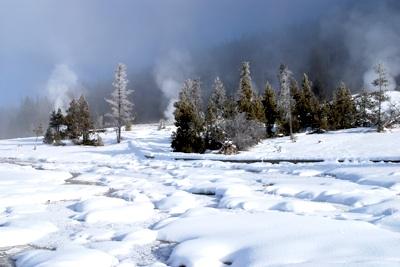“The snow tips the balance,” remarked Doug Smith, senior wildlife biologist and leader of the Yellowstone Wolf Project, about his research findings on winter wolf predation in Yellowstone National Park.
The statement also neatly summarized one of the key themes of the 10th Biennial Scientific Conference in Yellowstone: Considering the radically different environment that less snow -- and less moisture from snowmelt -- might produce in the Greater Yellowstone Ecosystem in the years to come.
As 70 percent of the water supply in the western United States is derived from melting snow, a reduced snow pack can initiate a chain reaction that reverberates across the region. According to the findings presented at the recent conference by scientists, a drier climate has consequences for a wide range of flora and fauna -- everything from butterfly populations, to invasive plant establishments, to elk foraging patterns, to the health of hibernating grizzly bears, to the survival of native trout.
With wolves, biologist Smith found that “big climatic patterns associated with snowfall are impacting the wolf kill rate.” For example, a recent trend of wolves switching from predation of calves to bulls as prey can be partially attributed to drought -- the bull elk are entering early winter in poorer condition, thus making them easier to kill. Dr. Smith also showed two photos that displayed how snow-cover affects wolf hunting strategies -- one of a successful kill by a wolf pack of an elk trapped in deep snow, the other of an elk evading wolves by simply outrunning the pack in a winter landscape bare of snow.
Along with climate change, the conference, entitled Questioning Greater Yellowstone’s Future, addressed the area’s two other primary challenges -- land use and invasive species -- and sought solutions to protect the GYE from all three of these key drivers of change. Dr. Marcia McNutt, director of the USGS, spoke to the importance of finding these solutions: “Yellowstone, like many of America’s great places, is many things to many people, but what it can never be is a failed scientific experiment.”
Discussing how to protect an area that contains one of the world’s best-protected places might appear counter-intuitive, but ‘what happens outside of Yellowstone doesn’t stay outside of Yellowstone’ served as another common theme of the conference findings, with several presentations demonstrating that external environmental disturbances impact the world’s first national park. In his presentation on land use in the GYE, Montana State University’s Dr. Andrew Hansen spoke about development being built disproportionately in ecologically significant areas and wondered at what point will private use in those areas begin to "disturb the whole balance in the park?”
The Greater Yellowstone Ecosystem, an area stretching over 28,000 square miles and encompassing both Yellowstone and Grand Teton national parks and a handful of national forests, is one of the largest intact temperate ecosystems on the planet. Yet change -- from both global and local influences -- is already occurring at a rapid rate. Peak runoff from snowmelt is happening 10-20 days earlier and the growing season in the GYE has increased by two weeks. Invasive species adds threats as well, such as the lake trout driving out Yellowstone’s native cutthroat trout or the Canada thistle marginalizing wetlands. Additionally, human population in the GYE has grown by 61 percent from 1970 to 2000 and at the same time rural land under development has increased by 350 percent.
Maintaining the ecological integrity of the area given all these challenges may seem daunting, but it is one the scientists at the conference willingly tackled with the hopes that their research would yield viable solutions. “We have tools to deal with uncertainty and complexity,” said Dr. Stephen Gray, Wyoming State Climatologist, in reference to the task of adapting to what he refers to as the inevitable “fundamental change in the climate of this area.”
One perfect storm illustrating the complexity of climate change and its impacts on the GYE seems to be forming around the grizzly bear. The conference had no shortage of research on the topic, even dedicating an entire concurrent session on Ursine Adaptations to Ecological Change. Although scientists disagree on the extent and/or the source of the repercussions, a number of trends have the potential to stress the grizzly bear in the GYE, including warmer temperatures disrupting the animal’s hibernation patterns, human development and interactions in key habitat areas, and a reduction of the whitebark pine nut, one of the bear’s major food sources.
For all the hard science and technical abstracts presented over the three-day event, attendees did not ignore Yellowstone’s “narcotic allure.” As PhD candidate Kristen Marshall discussed data on the relationship of willow growth rates to hydrological conditions, she stopped twice to laugh in delight as a bull elk bugled loudly outside the Mammoth Hot Springs Hotel, an action in keeping with keynote Dr. Judith Meyer’s admonishment the next day: “When we are counting beetles or measuring rainfall, let us not forget the wonder of this place.”




Comments
Beth -- thanks for sharing the article and great pictures. I spend much of my free time in Yellowstone, just enjoying the wilderness and photographing the animals. A friend and I were delighted one evening when driving by West Thumb we discovered a tiny geiser very near the road. To us it looked like a small version of Old Faithful. When I got home I searched the internet and found it to be Lone Pine Geiser and that we were lucky to be there and see its display. I recenly discovered an underwater geiser at the east end of Yellowstone Lake. It is at the early stone-walled pull out just as you begin the drive around the lake. I have checked it periodically and it is always active. Last week, I took a picture of it. A park visitor told me there are many geisers under the lake -- makes me wonder how the water temperature is affected by them.
Thanks again, for a great article.
Sonja